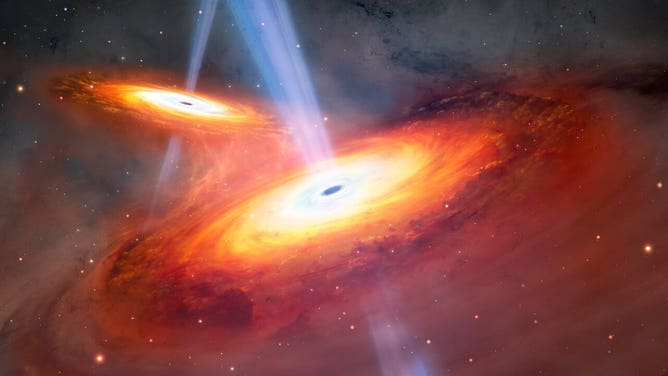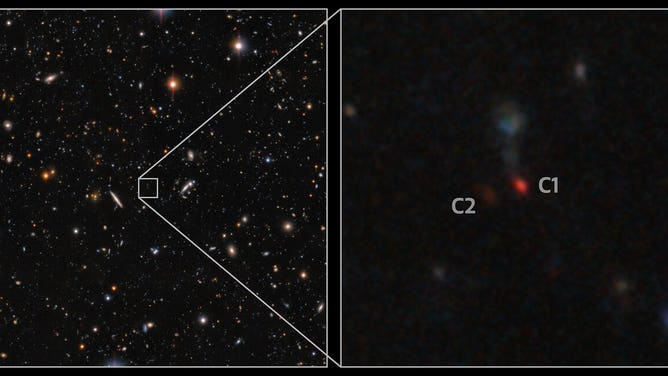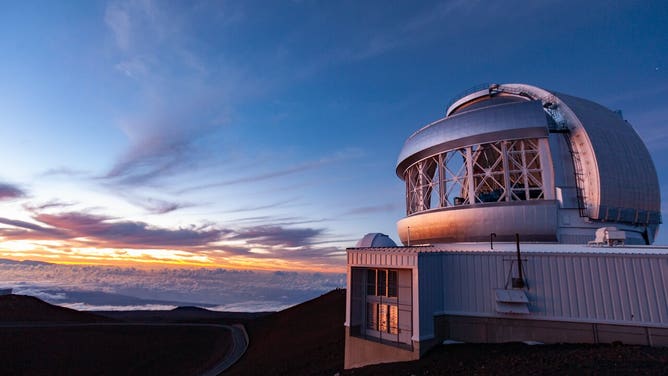Astronomers find record-breaking pair of galaxy cores merging at Cosmic Dawn
Quasars are the extremely bright cores of galaxies where gas and dust fall into supermassive black holes. A team of international astronomers found the most distant pair of merging quasars ever and the first pair confirmed in the period of the universe known as the Cosmic Dawn.
Astronomers discover merging quasars at Cosmic Dawn
With the help of the powerful GNIRS instrument on the Gemini North telescope, a team of astronomers have discovered a double-record-breaking pair of quasars. Not only are they the most distant pair of merging quasars ever found, but also the only pair confirmed in the bygone era of the Universe’s earliest formation.
During the first billion years after the Big Bang, known as the Cosmic Dawn, astronomers expect to see more interaction and merging of galaxies in the young universe. Still, until now, scientists have yet to see a pair of bright galactic cores close together.
Using the Gemini North and Subaru telescopes on Mauna Kea in Hawaii, a team of international astronomers said they have found the most distant pair of merging quasars ever and the first pair confirmed in the period of the universe known as the Cosmic Dawn. Their findings were published this month in The Astrophysical Journal Letters.

This illustration depicts two quasars in the process of merging.
(International Gemini Observatory/NOIRLab/NSF/AURA/M. Garlick)
According to the U.S. National Science Foundation’s NOIRLab, quasars are the extremely bright cores of galaxies where gas and dust fall into supermassive black holes.
The cosmic event happened 900 million years after the Big Bang, within the Cosmic Dawn – when the first stars and galaxies began appearing. This period started a new formation era known as the Epoch of Reionization.
"The existence of merging quasars in the Epoch of Reionization has been anticipated for a long time," said the study author Yoshiki Matsuoka, an astronomer at Ehime University in Japan. "It has now been confirmed for the first time."
Astronomers have been trying to find and study quasars during the Epoch of Reionization because of what they can tell us about the history of the early universe.
"The statistical properties of quasars in the Epoch of Reionization tell us many things, such as the progress and origin of the reionization, the formation of supermassive black holes during Cosmic Dawn, and the earliest evolution of the quasar host galaxies," Matsuoka said.

This image, taken with the Hyper Suprime-Cam on the Subaru Telescope, shows a pair of quasars in the process of merging. The faint patches of red caught the eye of astronomers and follow-up spectroscopy with the Gemini North telescope, one half of the International Gemini Observatory, which is supported in part by the U.S. National Science Foundation and operated by NSF NOIRLab, confirmed that these objects are quasars.
(NOIRLab/NSF/AURA/T.A. Rector (University of Alaska Anchorage/NSF NOIRLab), D. de Martin (NSF NOIRLab) & M. Zamani (NSF NOIRLab))
While 300 quasars were discovered at this time, none of them were in pairs. However, the newly discovered pair was found by accident as Matsuoka and his fellow researchers looked through images taken by the Hyper Suprime-Cam on the Subaru Telescope, also on Mauna Kea.
"While screening images of quasar candidates I noticed two similarly and extremely red sources next to each other," Matsuoka said. "The discovery was purely serendipitous."
PASS THE BIB: WATCH AS STUDY SIMULATES BLACK HOLES EATING GALAXY STARS LIKE MESSY TODDLERS
The quasars were too faint to confirm using near-infrared light. The team confirmed the quasar pair after characterizing their host galaxies using the Gemini North telescope.

The Gemini North telescope on Maunakea in Hawaii on a rare cloudy evening as the telescope prepares for nighttime operations.
(International Gemini Observatory/NSF’s NOIRLab/AURA/J. Pollard)
Astronomers use our Sun's mass as a relative measure for huge things in the universe, such as black holes. The two black holes at the centers of these galaxies are each estimated to be 100 million times the mass of our Sun.
According to NSF’s NOIRLab, astronomers will likely make more discoveries like this once the decade-long survey using the Vera C. Rubin Observatory begins next year.
